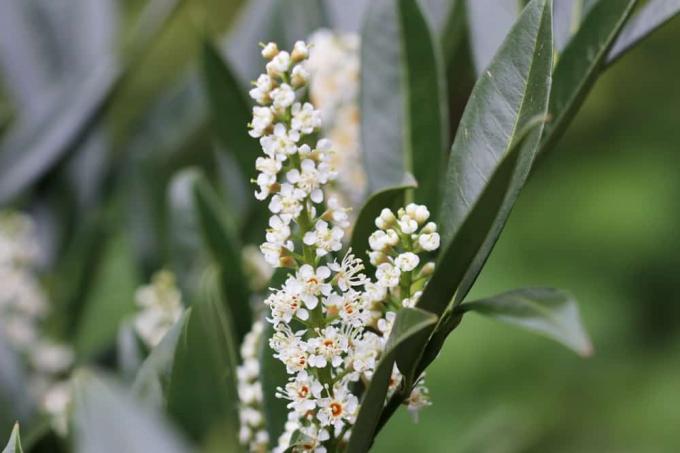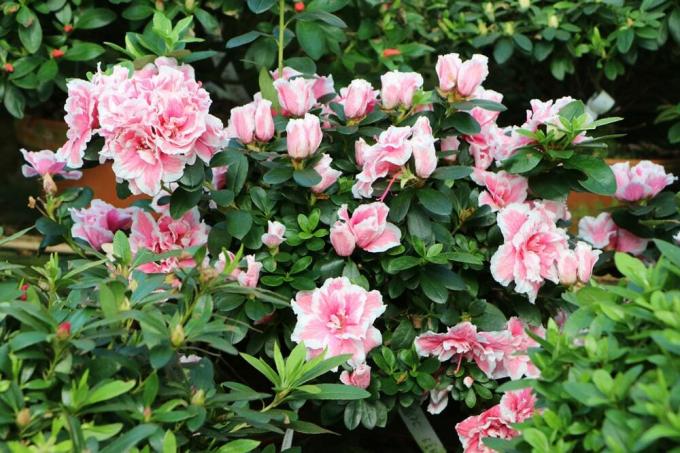

Table of contents
- origin and appearance
- Location
- substrate
- Pour
- Fertilize
- hibernate
- Cut
- planting time
- diseases and pests
- mildew
- shotgun disease
- Measures
- frequently asked Questions
- Worth knowing about the Portuguese cherry laurel shortly
- Conclusion
Prunus lusitanica belongs to the rose family of plants. It is undemanding and forms a dense growth over time. As a heat-loving ornamental shrub, the Portuguese cherry laurel is extremely frost hardy and can withstand temperatures down to minus 20 °C. On the other hand, it also withstands extremely high temperatures and gets along well with short dry periods. The attractive flower clusters immerse the foliage of the Portuguese princess in a creamy white sea of flowers. The hedge plant resembles the true laurel, but is nevertheless not related to it.
origin and appearance
As the name almost suggests, the Portuguese tree is native to the Azores and the Canary Islands, across the Iberian Peninsula to south-west France. There it looks for sunny locations in juniper forests and crater canyons. However, the pure wild form can be found almost nowhere today. The Mediterranean plant owes its name to the Roman province of Lusitanica (present-day Portugal).
Prunus lusitanica reaches a height of up to four meters in the home garden and takes up a space of up to two and a half meters in width. Depending on the location and pruning, the plant increases in size by 20 to 35 cm per year. The bushy and upright growing ornamental shrub shows its new shoots in a handsome shade of red. The glossy leaves are leathery, dark green, ovate acuminate and set with a showy red petiole. The creamy white flowers are erect and produce ovoid, dark red drupes. The plant is well suited as a hedge and can also be cultivated as a container plant.
Location
It does not take much effort to find the optimal location for the Mediterranean plant, as it is quite undemanding. Due to its origin, it is sun-drenched and therefore thrives best in a sunny to partially shaded spot. Although the Portuguese princess tolerates heat, it should be protected from the cool east wind.
substrate
This cherry laurel variety, which likes to show itself with countless small white flower clusters, also makes no special demands on the soil conditions. Basically, the plant prefers a loose and permeable soil. Such a soil ensures that no waterlogging can accumulate in the area of the roots. Because waterlogging harms the well-being of the Prunus lusitanica in the long run. It is also an advantage if the tree is planted in sandy-clayey, gritty-loamy or sandy-loamy soil.
Tip:
In order to emphasize the advantages of this plant, a nutrient-rich, slightly acidic to strongly alkaline soil is recommended.
Pour
It has a positive effect on the appearance and growth of the Mediterranean beauty if it is watered less frequently, but penetratingly. Thorough watering encourages the plant's roots to reach deeper layers of soil and thus survive brief dry spells.
Tip:
In order to prevent fungal diseases, it should really only be watered when the surface has dried out.
Fertilize
Basically, the Portuguese cherry laurel does not need to be fertilized. The ornamental shrub is well taken care of for the first time if manure, horn shavings or compost are introduced into the soil when planting. Furthermore, commercial liquid fertilizer can be used so that the shrub is sufficiently supplied with nutrients. Fertilization is stopped from August, otherwise too many new shoots will form, which will react sensitively to the coming cold.
hibernate
Although the Prunus lusitanica can withstand temperatures down to -20 °C, the root area should not only be covered with young plants. Fir branches and leaves are suitable for covering. An extra layer of mulch provides the Portuguese laurel with nutrients. Delicate little shrubs that are about to face their first winter will appreciate protection from branches. As an evergreen tree, the cherry laurel needs sufficient water even in winter. Otherwise it reacts with brown leaves after the winter months. However, watering is only done on frost-free days.
Cut
In principle, the Prunus lusitanica can be cut back all year round - except in the case of frost and on hot days in summer. Pruning is done after flowering. The shoots are shortened five to ten centimeters. This has the advantage that the plant thrives better and will be in full bloom next year. Of course, the shoot tips can also be trimmed in between. This creates more branches. Mechanical hedge trimmers are recommended for cutting. An electric hedge trimmer can leave brown edges on the leaves.
planting time
Roots, i.e. plants without balls, are best planted by the end of April. Autumn is also the perfect time to plant. Container goods can be placed in the ground all year round. In case of drought, ensure adequate watering. The planting hole should be twice the size of the ball. Horn shavings, manure or compost can be sprinkled in as slow-release fertiliser. No more than three plants are planted per meter in the ground. Finally water well.
diseases and pests
The most common diseases of cherry laurel are fungal diseases that severely affect the metabolism of the plant.
mildew
- mealy coating on the leaves
- growing leaves are misshapen
- Foliage turns yellow to brown
- trained foliage is usually not affected
shotgun disease
- small, bright spots in the leaf area
- red to brown spots on the leaves
- Disease also affects fruit, causing it to stun or crack open
- sometimes shoots are also affected
Measures
- Remove infested leaves and dispose of with household waste
- Use fungicide preparations
- possibly additional copper donations

frequently asked Questions
Prunus lusitanica can reach a height of four and a half to six meters. The width varies between three and five meters. No more than three plants per meter are planted as a hedge.
All parts of the plant, including the fruit, are poisonous. The leaves and seeds in particular have a high toxic potential. After consumption, the glycosides contained in the plant parts release hydrocyanic acid in the stomach. More than ten seeds can be deadly.
Repotting means changed living conditions for the cherry laurel. It is enough to cut back the affected branches. If the wood is cultivated as a container plant, the container must be of sufficient size. It is also advisable to lay drainage so that rainwater can run off unhindered.
Worth knowing about the Portuguese cherry laurel shortly
Care
- The Portuguese cherry laurel has no special requirements when it comes to soil conditions, it is content with an ordinary garden soil.
- It likes a sunny or partially shaded location best.
- Because the plant originally comes from the Iberian Peninsula, the Azores and the Canary Islands, it also tolerates heat very well.
- In its homeland, however, the Portuguese cherry laurel is only rarely found in the wild.
Planting time and winter care
- The best planting time for root crops, i.e. plants without a ball of pots, is spring to the end of April.
- Plants in a container, on the other hand, can be planted all year round.
- In dry weather, however, care should be taken to ensure adequate watering.
- Although this cherry laurel is very hardy, new plants should still get winter protection in the first year.
- Young plants can also be somewhat sensitive to strong winter sun or cold winds.
Pruning of cherry laurel
- In principle, the Portuguese cherry laurel can be pruned all year round.
- The only exceptions to this are the times when it freezes and the summer months when it is very hot and dry.
- For gardeners, however, the time around St. John's Day on April 24 is particularly important. June is a popular time for a cut.
- In general, it is sufficient to shorten the shoots by about 5 to 10 cm once a year.
- However, the shoot tips can also be trimmed more often, because this creates more branches.
Tip:
Because light brown edges form on the leaves when using electric hedge trimmers, it is advisable to cut young plants in particular by hand.
Conclusion
The Prunus lusitanica is well suited as a hedge plant because it grows up to two meters high and can grow up to 30 cm per year. It can also reach dimensions of up to one and a half meters in width. It forms many branches, so that the hedge becomes very dense and thus forms a good privacy screen. The more you cut, the denser the hedge will be. Depending on the size of the plants, two to three plants per running meter are needed for a hedge.
 garden editorial
garden editorial I write about everything that interests me in my garden.
Learn more about shrubs and woody plants

17 flowering hardy plants May to October
Many plants only show their full splendor for a short time. But there are also types and varieties with a particularly long flowering period from May to October, sometimes even longer. We present 17 flowering hardy plants.

25 hardy and evergreen ornamental trees
Ornamental trees are among the most popular plants in the garden. They have a decorative effect and set special accents in the green oasis. If you are tired of the gray of the cold season, you can plant trees that are hardy and evergreen.

Is barberry poisonous? | What is to be considered?
With their dense growth, numerous thorns and evergreen foliage, barberries are one of the most popular types of plants for a hedge in the garden. Before cultivating the sour thorn family (Berberidaceae), many ask themselves whether the plant is poisonous.

Azalea location: 6 important criteria
Azaleas are a flowering addition to the garden or living room, as long as they are in the right location. In the following guide to azaleas, we will tell you what to look out for.

How fast does a rhododendron grow? | Information about growth
How fast a rhododendron grows depends on various factors, including the variety, location and care. Growth can be accelerated under optimal conditions, while deficiencies lead to stunted growth.

Butterfly bush: the ideal location | Buddleia
The uncomplicated, easy-care and robust butterfly bush is suitable in the garden for borders, a flowering hedge or as a solitaire. Dwarf summer lilacs are ideal for pot culture. Buddleia bloom from June to October and are a magnet for many butterflies.



